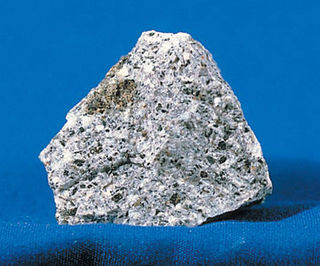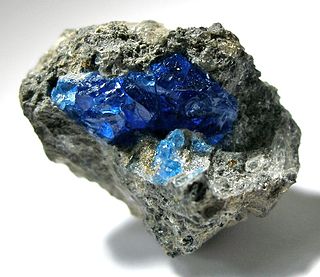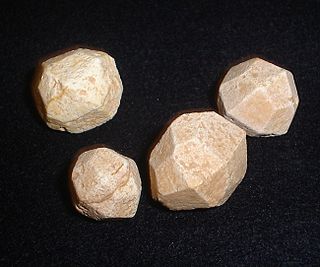
Gabbro is a phaneritic (coarse-grained), mafic intrusive igneous rock formed from the slow cooling of magnesium-rich and iron-rich magma into a holocrystalline mass deep beneath the Earth's surface. Slow-cooling, coarse-grained gabbro is chemically equivalent to rapid-cooling, fine-grained basalt. Much of the Earth's oceanic crust is made of gabbro, formed at mid-ocean ridges. Gabbro is also found as plutons associated with continental volcanism. Due to its variant nature, the term gabbro may be applied loosely to a wide range of intrusive rocks, many of which are merely "gabbroic". By rough analogy, gabbro is to basalt as granite is to rhyolite.

Syenite is a coarse-grained intrusive igneous rock with a general composition similar to that of granite, but deficient in quartz, which, if present at all, occurs in relatively small concentrations. It is considered a granitoid. Some syenites contain larger proportions of mafic components and smaller amounts of felsic material than most granites; those are classed as being of intermediate composition.

Phonolite is an uncommon shallow intrusive or extrusive rock, of intermediate chemical composition between felsic and mafic, with texture ranging from aphanitic (fine-grained) to porphyritic (mixed fine- and coarse-grained). Phonolite is a variation of the igneous rock trachyte that contains nepheline or leucite rather than quartz. It has an unusually high (12% or more) Na2O + K2O content, defining its position in the TAS classification of igneous rocks. Its coarse grained (phaneritic) intrusive equivalent is nepheline syenite. Phonolite is typically fine grained and compact. The name phonolite comes from the Ancient Greek meaning "sounding stone" due to the metallic sound it produces if an unfractured plate is hit; hence, the English name clinkstone is given as a synonym.

Basanite is an igneous, volcanic (extrusive) rock with aphanitic to porphyritic texture. It is composed mostly of feldspathoids, pyroxenes, olivine, and plagioclase and forms from magma low in silica and enriched in alkali metal oxides that solidifies rapidly close to the Earth's surface.
The feldspathoids are a group of tectosilicate minerals which resemble feldspars but have a different structure and much lower silica content. They occur in rare and unusual types of igneous rocks, and are usually not found in rocks containing primary quartz. A notable exception where feldspathoids and quartz-bearing rocks are found together is the Red Hill Syenite.

Nepheline, also called nephelite (from Ancient Greek νεφέλη (nephélē) 'cloud'), is a rock-forming mineral in the feldspathoid group – a silica-undersaturated aluminosilicate, Na3KAl4Si4O16, that occurs in intrusive and volcanic rocks with low silica, and in their associated pegmatites. It is used in glass and ceramic manufacturing and other industries, and has been investigated as an ore of aluminium.

Nepheline syenite is a holocrystalline plutonic rock that consists largely of nepheline and alkali feldspar. The rocks are mostly pale colored, grey or pink, and in general appearance they are not unlike granites, but dark green varieties are also known. Phonolite is the fine-grained extrusive equivalent.

Ijolite is an igneous rock consisting essentially of nepheline and augite. Ijolite is a rare rock type of considerable importance from a mineralogical and petrological standpoint. The word is derived from the first syllable of the Finnish words such as Iivaara, Iijoki, common as geographical names in Finland, and the Ancient Greek Xiflos, a stone. Ijolite occurs in various parts of the Kainuu region of eastern Finland and in the Kola Peninsula of northwest Russia on the shores of the White Sea. Ijolite was first defined and named by Finnish geologist Wilhelm Ramsay.

Lamproite is an ultrapotassic mantle-derived volcanic or subvolcanic rock. It has low CaO, Al2O3, Na2O, high K2O/Al2O3, a relatively high MgO content and extreme enrichment in incompatible elements.
Theralite is, in petrology, the name given to calcic foidal gabbro, a plutonic hylocrystalline rock consisting of augite, olivine, calcic plagioclase (labradorite), and nepheline, along with accessories including biotite, magnetite, ilmenite and analcime.

In petrology, limburgite is a dark-colored volcanic rock resembling basalt in appearance, but containing normally no feldspar. The name derives from the type locality the Limberg or the Limburg, close to Sasbach am Kaiserstuhl in Baden-Württemberg, where they occur in the well-known rock of the Kaiserstuhl. They consist essentially of olivine and augite with a brownish glassy groundmass. The augite may be green, but more commonly is brown or violet; the olivine is usually pale green or colourless, but is sometimes yellow. Within the groundmass a second generation of small euhedral augites frequently occurs; more rarely olivine is present also as an ingredient of the matrix. The principal accessory minerals are ilmenite and apatite. Feldspar though sometimes present, is never abundant, and nepheline also is unusual. In some limburgites large phenocrysts of dark brown hornblende and biotite are found, mostly with irregular borders blackened by resorption; in others there are large crystals of anorthoclase. Hauyne is an ingredient of some of the limburgites of the Cape Verde Islands.- Rocks of this group occur in considerable numbers in Germany and in Bohemia, also in Scotland, Auvergne, Spain, Africa (Kilimanjaro) and Brazil. They are associated principally with basalts, nepheline and leucite basalts and monchiquites. From the last-named rocks the limburgites are not easily separated as the two classes bear a very close resemblance in structure and in mineral composition, though many authorities believe that the ground mass of the monchiquites is not a glass but crystalline analcite. Limburgites may occur as flows, as sills or dykes, and are sometimes highly vesicular. Closely allied to them are the augitites, which are distinguished only by the absence of olivine; examples are known from Bohemia, Auvergne, the Canary Islands and Ireland.

Hauyne or haüyne, also called hauynite or haüynite, is a tectosilicate sulfate mineral with endmember formula Na3Ca(Si3Al3)O12(SO4). As much as 5 wt % K2O may be present, and also H2O and Cl. It is a feldspathoid and a member of the sodalite group. Hauyne was first described in 1807 from samples discovered in Vesuvian lavas in Monte Somma, Italy, and was named in 1807 by Brunn-Neergard for the French crystallographer René Just Haüy (1743–1822). It is sometimes used as a gemstone.
Borolanite is an historical petrological name for a pyroxene-melanite bearing nepheline syenite variety which contains nepheline-alkali feldspar pseudomorphs interpreted to be after leucite which occur as conspicuous white spots in the dark rock matrix. The rock occurs in the Borralan Igneous Complex or Loch Borralan Complex which is an alkalic igneous complex near Loch Borralan in northwest Scotland.

Melilite refers to a mineral of the melilite group. Minerals of the group are solid solutions of several endmembers, the most important of which are gehlenite and åkermanite. A generalized formula for common melilite is (Ca,Na)2(Al,Mg,Fe2+)[(Al,Si)SiO7]. Discovered in 1793 near Rome, it has a yellowish, greenish-brown color. The name derives from the Greek words meli (μέλι) "honey" and lithos (λίθους) "stone".The name refers to a group of minerals (melilite group) with chemically similar composition, nearly always minerals in åkermanite-gehlenite series.

Leucitite or leucite rock is an igneous rock containing leucite. It is scarce, many countries such as England being entirely without them. However, they are of wide distribution, occurring in every quarter of the globe. Taken collectively, they exhibit a considerable variety of types and are of great interest petrographically. For the presence of this mineral it is necessary that the silica percentage of the rock should be low, since leucite is incompatible with free quartz and reacts with it to form potassium feldspar. Because it weathers rapidly, leucite is most common in lavas of recent and Tertiary age, which have a fair amount of potassium, or at any rate have potassium equal to or greater than sodium; if sodium is abundant nepheline occurs rather than leucite.
Schäferite is a rare vanadate mineral with chemical formula Ca2NaMg2[VO4]3. Schäferite is isometric, which means that it has three axes of equal length and 90° angles between the axes. Schäferite is isotropic, meaning that the velocity of light is the same no matter which direction the light passes through.

Bassanite is a calcium sulfate mineral with formula CaSO4·1/2H2O or 2CaSO4·H2O. In other words it has half a water molecule per CaSO4 unit, hence its synonym calcium sulfate hemihydrate.
São Tomé and Príncipe both formed within the past 30 million years due to volcanic activity in deep water along the Cameroon line. Long-running interactions with seawater and different eruption periods have generated a wide variety of different igneous and volcanic rocks on the islands with complex mineral assemblages.
The alkaline magma series is a chemically distinct range of magma compositions that describes the evolution of an alkaline mafic magma into a more evolved, silica-rich end member.













